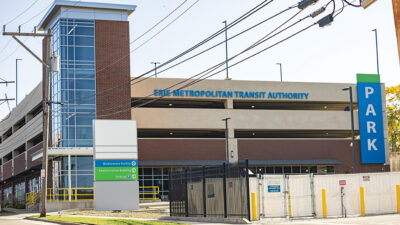Language in the university’s scope of work for a dormitory’s renovation required clarity.

This university dormitory renovation project is currently in the design stage, and is using building information modeling as part of the deliverable incorporated into the design contract. Because the project is still in the bidding process, the client has been kept confidential.
In July 2017 CannonDesign contracted with a major university client to perform the design of a comprehensive renovation for two existing dormitory buildings. Project scope includes window replacement, all new electrical and heating, ventilation and air conditioning systems and complete reconfiguration of the toilet rooms, including all new plumbing.
Other than these elements, the buildings are planned to remain as–is. The contract for design deliverables includes development of two-dimensional procurement drawings and specifications, however the university also required that building information modeling be used on the project. The language included in the scope of work from the university stated:
“BIM will be used on this project The project will use the National Institute of Building Sciences’ BIM standards and guidelines for level of development 3 (BIM-3) that may be linked to limited shared databases, which contain facility plans, design specifications, schedules and other documents related to the building for purposes that shall include cost estimating, budget control, material take-offs, visual verification, interface management, project sequencing, system conflicts and clash detection.”
There are several interesting aspects to the SOW request:
- The SOW references an LOD 3 as well as NIBS-US BIM-3 as guidelines for the model. This is an incorrect reference related to LOD 3, as LOD does not refer to an entire model, only to specific elements in that model. The reference to BIM-3 further complicates this reference primarily due to the fact that it is a renovation project. While it may make sense for certain elements (such as newly installed infrastructure components) to be modeled to LOD 3 and to incorporate the ability to link to external databases, it does not make sense for many of the existing to remain building components to be developed to that level.
- In another portion of the SOW, the university makes it clear that the project will be bid using plans and specifications and makes no reference to the delivery of a model for procurement purposes. Understanding this and given the repetitive nature of the work within the 500+ student rooms (the majority of which are identical in layout), the most efficient approach to creating the two-dimensional documentation is a hybrid BIM approach that models the repetitive elements in detail while referencing these details as “typical” wherever possible.
- The SOW additionally requires the professional services consultant (or designer) to produce a BIM execution plan and to be responsible for the initial and continued management of the model. This requirement rightly places the impetus for defining how the model will be developed and managed through the design and beyond. It also recognizes that there will be additional contributors to the model (such as the contractors) as the project progresses.
Ultimately, through conversations with the university, their goals for using the BIM moving forward were determined. They were amenable to a documentation plan that efficiently developed the standard two-dimensional procurement documents their process required as long as a BIM also was developed that could serve as a vehicle for coordination by the contractor during installation and as a host to their computerized maintenance management system process in the long term. Specific elements that are being incorporated into the BIM during the design process include:
- The existing building elements to an LOD 100 level to act as the host for new distribution using existing Autodesk AutoCAD drawings of the building as a base.
- Each typical student room type, including the new HVAC equipment and internal room distribution for mechanical and electrical to an LOD level 300 to allow for coordination, quantification and specific references for each element.
- Each typical toilet room type — including the new plumbing fixtures, piping and internal room distribution for plumbing, mechanical and electrical — to an LOD level 300 to allow for coordination, quantification and specific references for each element.
- The new HVAC and plumbing main distribution to a level 200 to allow for further development by the contractor prior to installation.
- The new electrical distribution to an LOD level 200 with each electrical panel developed to an LOD level 300.
Further discussions remain regarding how the model will ultimately be used by the contractor and what responsibility will be delegated for conforming the model to a final as-built condition once the project has been completed. These discussions will lead to the incorporation of specific requirements within the BIM execution plan that will assign tasks to each of the installing contractors. The execution plan will be issued as part of the procurement package and included in the contract between the owner and contractor.



